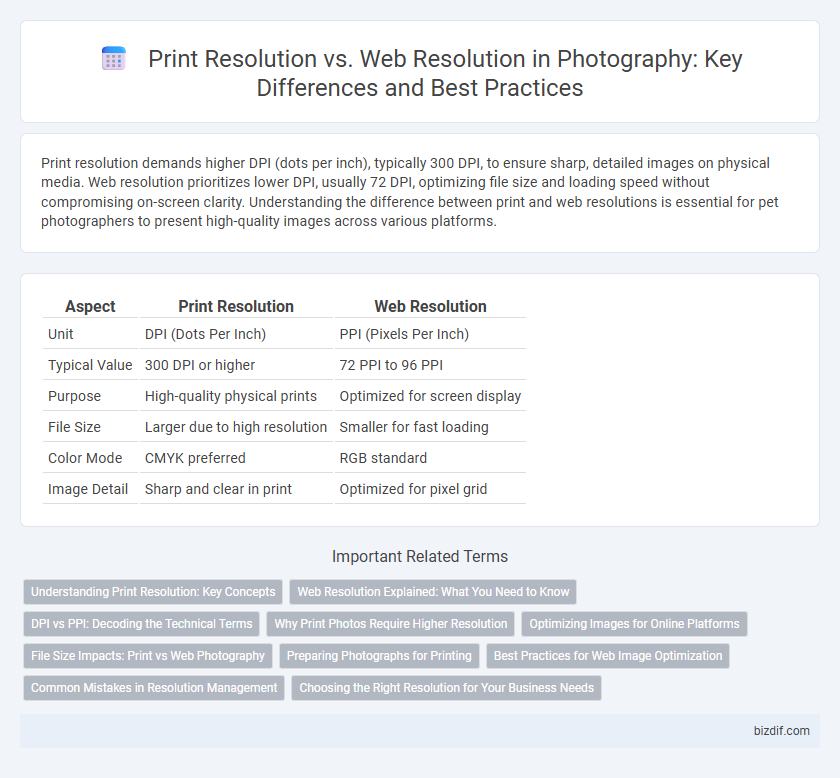Print resolution demands higher DPI (dots per inch), typically 300 DPI, to ensure sharp, detailed images on physical media. Web resolution prioritizes lower DPI, usually 72 DPI, optimizing file size and loading speed without compromising on-screen clarity. Understanding the difference between print and web resolutions is essential for pet photographers to present high-quality images across various platforms.
Table of Comparison
| Aspect | Print Resolution | Web Resolution |
|---|---|---|
| Unit | DPI (Dots Per Inch) | PPI (Pixels Per Inch) |
| Typical Value | 300 DPI or higher | 72 PPI to 96 PPI |
| Purpose | High-quality physical prints | Optimized for screen display |
| File Size | Larger due to high resolution | Smaller for fast loading |
| Color Mode | CMYK preferred | RGB standard |
| Image Detail | Sharp and clear in print | Optimized for pixel grid |
Understanding Print Resolution: Key Concepts
Print resolution is measured in dots per inch (DPI), typically requiring a minimum of 300 DPI for sharp, high-quality images in printed materials. Unlike web resolution, which is based on pixels per inch (PPI) optimized for screen viewing at 72 PPI, print resolution demands higher density to ensure clarity and detail. Understanding the distinction between these resolutions is essential for photographers to produce vivid prints without pixelation or loss of quality.
Web Resolution Explained: What You Need to Know
Web resolution typically refers to 72 pixels per inch (PPI), which is optimized for digital screens and faster loading times. Unlike print resolution that demands higher pixel density (usually 300 PPI) for sharp physical prints, web images prioritize pixel dimensions for clarity on various displays. Understanding web resolution ensures images remain visually appealing without unnecessarily large file sizes, enhancing website performance and user experience.
DPI vs PPI: Decoding the Technical Terms
DPI (dots per inch) refers to the number of ink dots a printer applies per inch to create detailed hard copies, directly influencing print quality. PPI (pixels per inch) describes the pixel density displayed on a digital screen, determining image clarity in web and digital formats. Understanding the distinction between DPI for printing and PPI for screens is crucial for optimizing image resolution across different media.
Why Print Photos Require Higher Resolution
Print photos require higher resolution, typically 300 DPI or more, to ensure sharp detail and smooth gradients on physical media. Unlike screens that display images at 72 DPI or 96 DPI, printed materials demand denser pixel information to prevent pixelation and maintain image quality. High-resolution prints preserve fine textures and colors accurately, crucial for professional photography and large-format prints.
Optimizing Images for Online Platforms
Optimizing images for online platforms requires understanding the difference between print resolution and web resolution, where print resolution typically uses 300 DPI for high-quality detailed output, while web resolution uses 72 DPI to balance image clarity and page load speed. High-resolution images intended for print often slow down website performance and increase bandwidth usage when used online, making resizing and compression essential. Maintaining proper pixel dimensions and file formats like JPEG or PNG ensures images display sharply without compromising website responsiveness.
File Size Impacts: Print vs Web Photography
Print resolution typically requires 300 DPI (dots per inch) to maintain image clarity, resulting in larger file sizes suitable for detailed physical prints, while web resolution uses 72 DPI to optimize faster loading times with significantly smaller file sizes. High print resolution files often exceed several megabytes due to increased pixel density, which can slow down digital workflows and require more storage space. In contrast, web images prioritize compressed file formats like JPEG or PNG at lower DPI to reduce bandwidth usage and improve user experience without sacrificing visible quality on screens.
Preparing Photographs for Printing
Preparing photographs for printing requires using a print resolution of at least 300 DPI (dots per inch) to ensure sharp, high-quality images, while web resolution typically uses 72 DPI for faster loading times on screens. Print resolution captures fine details and color accuracy essential for physical media such as brochures, magazines, and posters. Adjusting image size and resolution based on the specific print dimensions prevents pixelation and maintains professional output quality.
Best Practices for Web Image Optimization
Web image optimization requires using 72 DPI resolution, which balances quality and loading speed for digital displays. Higher print resolution images, typically 300 DPI, result in unnecessarily large file sizes that slow down website performance. Compressing images without compromising visual clarity enhances user experience and improves SEO rankings.
Common Mistakes in Resolution Management
Common mistakes in resolution management often involve confusing print resolution with web resolution, leading to poor image quality and file size issues. Print resolution typically requires 300 DPI (dots per inch) for sharp, detailed prints, while web images should be optimized at 72 PPI (pixels per inch) to balance clarity and faster loading times. Using print settings for digital use can cause unnecessarily large files, while using web resolutions for print results in pixelated, blurry images.
Choosing the Right Resolution for Your Business Needs
Selecting the correct print resolution involves using at least 300 DPI (dots per inch) to ensure sharp, high-quality images suitable for physical materials like brochures and posters. Web resolution is optimized at 72 PPI (pixels per inch), balancing clarity and fast loading times for websites and digital displays. Understanding these differences helps businesses deliver visually compelling content tailored to print or online platforms, improving brand presentation and user experience.
Print Resolution vs Web Resolution Infographic

 bizdif.com
bizdif.com